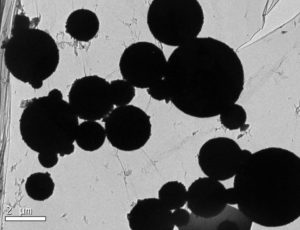 Did you know that some foods have nanoparticles added to them? Which means that you may be ingesting food nanoparticles without knowing it. There are currently hundreds of foods with nanoparticles in them, and it is estimated that people (in developed countries) consume more than 1012 nanoparticles in foods each day. The nanoparticles in foods are ingredients so small that they are measured in nanometers or billionths of one meter. The most common nanoingredients are: titanium dioxide, silicon dioxide, and zinc oxide.
Did you know that some foods have nanoparticles added to them? Which means that you may be ingesting food nanoparticles without knowing it. There are currently hundreds of foods with nanoparticles in them, and it is estimated that people (in developed countries) consume more than 1012 nanoparticles in foods each day. The nanoparticles in foods are ingredients so small that they are measured in nanometers or billionths of one meter. The most common nanoingredients are: titanium dioxide, silicon dioxide, and zinc oxide.
What, if anything, do nanoingredients do to humans? That is, are there any effects from ingesting them? Several articles in the past year raise a number of concerns, especially because so much is still unknown. Two recent studies, one done in the US. (using an intestinal model) and one in France (using rats) also raise similar health concerns.
The U. S. study found that the ability of small intestine cells to absorb nutrients and act as a barrier to pathogens is "significantly decreased" after chronic low-level exposure to nanoparticles of titanium dioxide. It affected the surface of the intestinal cells, called microvilli, of the small intestine in a negative way (it "induced a significant decrease in absorptive microvilli").
The French study found that 100 days of chronic low-level ingestion of titanium nanoparticles in food resulted in intestinal inflammation, that it crossed the intestinal barrier and passed into the bloodstream (and even to the liver), and there was development of "preneoplastic lesions" - thus leading the researchers to suggest that chronic low-level exposure plays a role in initiating and promoting early stages of colorectal cancer (colorectal carcinogenesis).
Meanwhile the use of nanoingredients is unregulated in the U.S., and the number of foods with nanoingredients is growing rapidly. About 36% of the titanium dioxide used in food is in titanium dioxide nanoparticle form. It is frequently found in processed foods such as candies, icing, and chewing gums, and is primarily used to make the food whiter or brighter. In the European Union titanium dioxide nanoparticles used as a food additive is known as E171.
Nanoparticles are typically used in foods as additives, flavorings, coloring, or even coatings for food packaging (which can then migrate or leach into food). It is thought that nanocoatings are being used on some fruits and vegetables. Even though ingredients such as titanium dioxide are considered to be "generally recognized as safe" (GRAS) before they're made into nanoparticles, the question is whether they’re safe in their nanoparticle form. This is because nanoparticles can exhibit new or altered properties at nanoscale dimensions.
Some concerns about nanoparticles are that they are small enough to penetrate the skin, lungs, digestive system, and perhaps pass through the blood-brain barrier and placental-fetal barrier, and cause damage. Some earlier studies raised the question of whether low-level inflammation of the intestines from chronic (daily) nanoparticle ingestion is contributing to intestinal bowel diseases or the development of colorectal cancer in humans. This research is in its infancy. Whew...
So if this concerns you, how can you avoid nanoparticles in food? Read food ingredient lists to avoid titanium dioxide, silicon dioxide, zinc oxide, and cut back (or avoid) eating processed foods as much as possible.
From Science Daily: Food additive found in candy, gum could alter digestive cell structure and function
The ability of small intestine cells to absorb nutrients and act as a barrier to pathogens is "significantly decreased" after chronic exposure to nanoparticles of titanium dioxide, a common food additive found in everything from chewing gum to bread, according to research from Binghamton University, State University of New York. Researchers exposed a small intestinal cell culture model to the physiological equivalent of a meal's worth of titanium oxide nanoparticles -- 30 nanometers across -- over four hours (acute exposure), or three meal's worth over five days (chronic exposure).
Acute exposures did not have much effect, but chronic exposure diminished the absorptive projections on the surface of intestinal cells called microvilli. With fewer microvilli, the intestinal barrier was weakened, metabolism slowed and some nutrients -- iron, zinc, and fatty acids, specifically -- were more difficult to absorb. Enzyme functions were negatively affected, while inflammation signals increased. "There has been previous work on how titanium oxide nanoparticles affects microvilli, but we are looking at much lower concentrations," Mahler said. "We also extended previous work to show that these nanoparticles alter intestinal function."
Titanium dioxide is generally recognized as safe by the U.S. Food and Drug Administration, and ingestion is nearly unavoidable.[Note: the FDA does not distinguish between regular titanium dioxide and titanium dioxide nanoparticles.] The compound is an inert and insoluble material that is commonly used for white pigmentation in paints, paper and plastics. It is also an active ingredient in mineral-based sunscreens for pigmentation to block ultraviolet light. However, it can enter the digestive system through toothpastes, as titanium dioxide is used to create abrasion needed for cleaning. The oxide is also used in some chocolate to give it a smooth texture; in donuts to provide color; and in skimmed milks for a brighter, more opaque appearance which makes the milk more palatable. "To avoid foods rich in titanium oxide nanoparticles you should avoid processed foods, and especially candy. That is where you see a lot of nanoparticles," Mahler said. [Original study.]
From Science Daily: Food additive E171: First findings of oral exposure to titanium dioxide nanoparticles
Researchers from INRA and their partners1 have studied the effects of oral exposure to titanium dioxide, an additive (E171) commonly used in foodstuffs, especially confectionary. They have shown for the first time that E171 crosses the intestinal barrier in animals and reaches other parts of the body. Immune system disorders linked to the absorption of the nanoscale fraction of E171 particles were observed. The researchers also showed that chronic oral exposure to the additive spontaneously induced preneoplastic lesions in the colon, a non-malignant stage of carcinogenesis, in 40% of exposed animals. Moreover, E171 was found to accelerate the development of lesions previously induced for experimental purposes. While the findings show that the additive plays a role in initiating and promoting the early stages of colorectal carcinogenesis, they cannot be extrapolated to humans or more advanced stages of the disease. The findings were published in the 20 January 2017 issue of Scientific Reports.
Present in many products including cosmetics, sunscreens, paint and building materials, titanium dioxide (or TiO2), known as E171 in Europe....Composed of micro- and nanoparticles, E171 is nevertheless not labelled a "nanomaterial," since it does not contain more than 50% of nanoparticles (in general it contains from 10-40%). The International Agency for Research on Cancer (IARC) evaluated the risk of exposure to titanium dioxide by inhalation (occupational exposure), resulting in a Group 2B classification, reserved for potential carcinogens for humans. [Original study.]
 There is tremendous concern about microplastics and what effects they have on humans when ingested (yes, they are found in our bodies). Microplastics are the tiny plastic particles that occur as plastic breaks down over time. They have been found in foods that we eat, water that we drink, and basically everywhere.
There is tremendous concern about microplastics and what effects they have on humans when ingested (yes, they are found in our bodies). Microplastics are the tiny plastic particles that occur as plastic breaks down over time. They have been found in foods that we eat, water that we drink, and basically everywhere.
 Once again research is finding effects on health from nanoparticles and air pollution - this time the heart. Tiny air pollution particles less than 100 nm (nanometers) in size are typically called "ultrafine particles", but actually they are so small that they are nanoparticles.
Once again research is finding effects on health from nanoparticles and air pollution - this time the heart. Tiny air pollution particles less than 100 nm (nanometers) in size are typically called "ultrafine particles", but actually they are so small that they are nanoparticles. How frequently do you eat foods with nanoparticles in them? The use of nanoparticles in foods is increasing every year, with the result that people may eat foods with them daily (thus having
How frequently do you eat foods with nanoparticles in them? The use of nanoparticles in foods is increasing every year, with the result that people may eat foods with them daily (thus having  Tattoos are very popular these days, with about
Tattoos are very popular these days, with about  The use of nanoparticles in foods is increasing every year, but we still know very little about whether they have health risks to humans, especially if one is eating foods with them daily (thus having chronic exposure). The
The use of nanoparticles in foods is increasing every year, but we still know very little about whether they have health risks to humans, especially if one is eating foods with them daily (thus having chronic exposure). The  This post is more on the theme of nanoparticles and human health. My
This post is more on the theme of nanoparticles and human health. My  Image of magnetite nanoparticles from the exhaust plume of a diesel engine. Credit Maher et al study, 2016.
Image of magnetite nanoparticles from the exhaust plume of a diesel engine. Credit Maher et al study, 2016. A microscopic image shows magnetite nanoparticles in the human brain. Barbara Maher et al study, 2016.
A microscopic image shows magnetite nanoparticles in the human brain. Barbara Maher et al study, 2016.